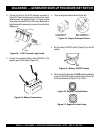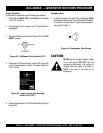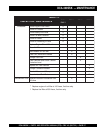
PAGE 54 — DCA-400SSK — PARTS AND OPERATION MANUAL (STD)— REV. #3 (09/17/01)
DCA-400SSK — MAINTENANCE
General Inspection
Prior to each use, the generating set should be cleaned and
inspected for deficiencies. Check for loose, missing or
damaged nuts, bolts or other fasteners. Also check for fuel
or oil leaks.
Air Cleaner
Every 50 hours: If dust indicator is red, clean the air cleaner
element.
Outer Element:
1. Loosen wing bolt, remove dust cup, then remove wing
nut and take out element.
2. Clean the inside of the body and cover using a damp
cloth.
3. Blow dry with compressed air (0.69Mpa [7kgf.cm
2
,
99.4 PSI] maximum) against the side of the element
along the pleats. Then blow dry against outside along
the pleats, then against inside again.
4. Remove one seal each time the element is cleaned.
5. Replace the outer element after cleaning it 6 times or
after one year. Replace the outer element if indicator is
red even after cleaning it.
6. Check the inner cylinder element clamping nut for
looseness, and retighten if necessary.
7. If seal washer is damaged or the threads of wing nut are
damaged, replace.
8. Remove evacuator valve and clean it with compressed
air. Reinstall.
Inner element (if equipped)
1. Remove the cover and outer element, then remove the
inner element.
2. Cover the air connector opening (outer side) with clean
cloth or cloth tape.
3. Clean the inside of the body. Remove air connector
opening protection.
4. Install a new inner cylinder element to the cylinder and
tighten the nut.
5. Install element.
6. After replacing the element, press the button of the dust
indicator to return the red piston to its original position.
Cleaning the Fuel Strainer
Clean the fuel strainer if it contains dust or water. Remove
dust or water in the strainer cap and wash it in diesel. Securely
fasten the fuel strainer cap so that fuel will not leak. Check
the fuel strainer every 200 hours of operation or once a month.
Check Oil Level
Check the crankcase oil level prior to each use, or when the
fuel tank is filled. Insufficient oil may cause severe damage
to the engine. Make sure the generator is level. The oil level
must be between the two notches on the dipstick as shown
in Figure 28, page 43.
Flushing Out Radiator and Changing Coolant
1. Stop the engine and allow to cool. Tighten valve of the
corrosion resistor (if equipped).
2. Turn water filer cap slowly and remove it.
3. Prepare a container to catch the coolant, then open drain
plug of the radiator or heat exchanger and drain plug of
the engine, and drain the coolant.
4. After draining the coolant, close drain plugs and fill with
tap water.
Fuel Addition
Add diesel fuel (the grade may vary according to season
and locations). Always pour through the mesh filter.
Removing Water from the Tank
After prolonged use, water and other impurities accumulate
in the bottom of the tank. Occasionally remove the drain
cock and drain the contents. During cold weather, the greater
the empty volume inside the tank, the easier it is for water to
condense. This can be reduced by always keeping the tank
as full as possible.
Air Removal
If air enters the fuel injection system of a diesel engine,
starting becomes impossible. After running out of fuel, or
after disassembling the fuel system, bleed the system
according to the following procedure.
To restart after running out of fuel, turn the key switch to the
“START” position for 15-30 seconds. Try again, if needed.
This unit is equipped with an automatic air bleeding system.
Service Daily
If engine is operating in very dusty and dry grass conditions,
a clogged air cleaner will result in high fuel consumption,
loss of power and excessive carbon buildup in the
combustion chamber.


















